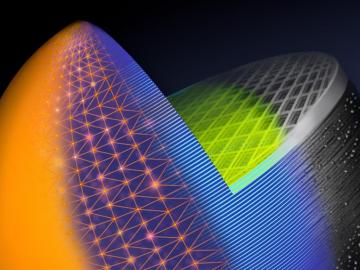
Filter News
Area of Research
- Advanced Manufacturing (3)
- Biological Systems (1)
- Biology and Environment (18)
- Clean Energy (54)
- Computational Biology (1)
- Electricity and Smart Grid (1)
- Fusion and Fission (5)
- Isotopes (17)
- Materials (28)
- Materials for Computing (2)
- National Security (16)
- Neutron Science (12)
- Nuclear Science and Technology (5)
- Supercomputing (24)
News Type
News Topics
- (-) 3-D Printing/Advanced Manufacturing (36)
- (-) Big Data (21)
- (-) Biomedical (28)
- (-) Cybersecurity (14)
- (-) Energy Storage (28)
- (-) Grid (23)
- (-) Isotopes (26)
- (-) Physics (28)
- (-) Security (10)
- (-) Space Exploration (12)
- Advanced Reactors (8)
- Artificial Intelligence (45)
- Bioenergy (49)
- Biology (57)
- Biotechnology (10)
- Buildings (17)
- Chemical Sciences (21)
- Clean Water (14)
- Climate Change (47)
- Composites (6)
- Computer Science (81)
- Coronavirus (17)
- Critical Materials (1)
- Decarbonization (43)
- Education (1)
- Emergency (2)
- Environment (100)
- Exascale Computing (24)
- Fossil Energy (4)
- Frontier (23)
- Fusion (29)
- High-Performance Computing (42)
- Hydropower (5)
- ITER (2)
- Machine Learning (21)
- Materials (40)
- Materials Science (43)
- Mathematics (5)
- Mercury (7)
- Microelectronics (2)
- Microscopy (20)
- Molten Salt (1)
- Nanotechnology (16)
- National Security (34)
- Net Zero (8)
- Neutron Science (47)
- Nuclear Energy (52)
- Partnerships (15)
- Polymers (8)
- Quantum Computing (20)
- Quantum Science (30)
- Renewable Energy (1)
- Simulation (30)
- Software (1)
- Summit (30)
- Sustainable Energy (43)
- Transformational Challenge Reactor (3)
- Transportation (27)
Media Contacts

Researchers at ORNL have developed the first additive manufacturing slicing computer application to simultaneously speed and simplify digital conversion of accurate, large-format three-dimensional parts in a factory production setting.

Researchers used quantum simulations to obtain new insights into the nature of neutrinos — the mysterious subatomic particles that abound throughout the universe — and their role in the deaths of massive stars.

Leadership Tennessee has named Clarice Phelps to its 2024–2025 Signature Program Class XI to collaborate with professionals statewide to address Tennessee’s most serious issues.

In May, the Department of Energy’s Oak Ridge and Brookhaven national laboratories co-hosted the 15th annual International Particle Accelerator Conference, or IPAC, at the Music City Center in Nashville, Tennessee.

Momentum for manufacturing innovation in the United States got a boost during the inaugural MDF Innovation Days, held recently at the U.S. Department of Energy Manufacturing Demonstration Facility at Oak Ridge National Laboratory.

Researchers set a new benchmark for future experiments making materials in space rather than for space. They discovered that many kinds of glass have similar atomic structure and arrangements and can successfully be made in space. Scientists from nine institutions in government, academia and industry participated in this 5-year study.

Students from the first class of ORNL and Pellissippi State Community College's joint Chemical Radiation Technology Pathway toured isotope facilities at ORNL.

When scientists pushed the world’s fastest supercomputer to its limits, they found those limits stretched beyond even their biggest expectations. In the latest milestone, a team of engineers and scientists used Frontier to simulate a system of nearly half a trillion atoms — the largest system ever modeled and more than 400 times the size of the closest competition.

ORNL researchers have teamed up with other national labs to develop a free platform called Open Energy Data Initiative Solar Systems Integration Data and Modeling to better analyze the behavior of electric grids incorporating many solar projects.

ORNL scientists are working on a project to engineer and develop a cryogenic ion trap apparatus to simulate quantum spin liquids, a key research area in materials science and neutron scattering studies.


